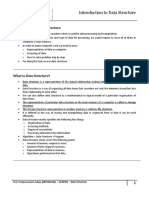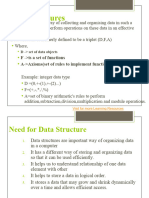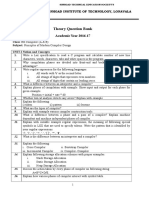0% found this document useful (0 votes)
88 views12 pagesIntroduction To Data Structures
This document introduces data structures and their importance for efficient programming. It defines a data structure as the logical organization of data in computer memory. Data must be organized efficiently to speed up programs through faster data retrieval. The document classifies data structures as primitive (basic data types) or non-primitive. Non-primitive structures are further divided into linear structures, where elements are stored sequentially, and non-linear structures, where relationships between elements are not sequential. Common operations on data structures like traversing, searching, inserting, deleting, sorting, and merging are also outlined. Real-life examples of when different data structures would be useful are provided.
Uploaded by
KalyanCopyright
© © All Rights Reserved
We take content rights seriously. If you suspect this is your content, claim it here.
Available Formats
Download as PPTX, PDF, TXT or read online on Scribd
0% found this document useful (0 votes)
88 views12 pagesIntroduction To Data Structures
This document introduces data structures and their importance for efficient programming. It defines a data structure as the logical organization of data in computer memory. Data must be organized efficiently to speed up programs through faster data retrieval. The document classifies data structures as primitive (basic data types) or non-primitive. Non-primitive structures are further divided into linear structures, where elements are stored sequentially, and non-linear structures, where relationships between elements are not sequential. Common operations on data structures like traversing, searching, inserting, deleting, sorting, and merging are also outlined. Real-life examples of when different data structures would be useful are provided.
Uploaded by
KalyanCopyright
© © All Rights Reserved
We take content rights seriously. If you suspect this is your content, claim it here.
Available Formats
Download as PPTX, PDF, TXT or read online on Scribd
/ 12






















































































